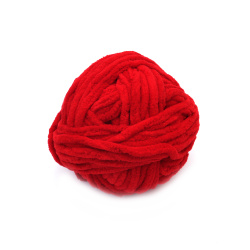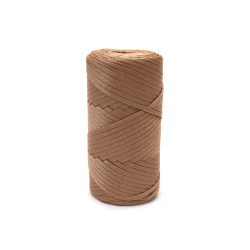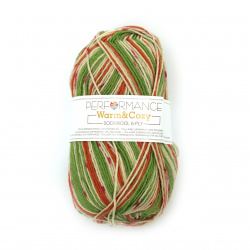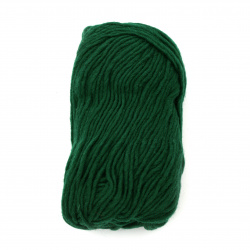Yarns for Embroidery, Craft and Sewing
EM ART is proud of its unique collection of yarns that have been carefully selected for all kinds of creative purposes. Starting with extremely delicate bamboo and silk fibers, pure cotton or merino wool, you will come across pure wool with its distinctly raw, natural character and ethno-style translucent colors. There are also monochrome variants in all sorts of shades, covering the entire spectrum of colors. You will also get artificial yarns made of acrylic, polyacrylic and polyester, blended yarns and developments with add-ons such as astragana, sequins and llama.
View more
Yarn POP ART / 20% Soft Wool, 80% Acrylic, Multicolored, 200 meters - 100 grams

Yarn Polychrome / 100% Acrylic, Multicolored, 360 meters - 100 grams

Yarn POP ART / 20% Soft Wool, 80% Acrylic, Dark Multicolored, 200 meters - 100 grams

Yarn Polychrome / 100% Acrylic, Multicolored Parrot, 360 meters - 100 grams

Yarn Ribbon (100% Polypropylene), Color: Dark Petroleum - 110 meters - 250 grams

100% Wool Felt Strip, 1500 mm, Extra Quality, White - 50 grams

Worsted Yarn: 20% Cotton, 80% Milk Cotton / Light Peach Color - 50 grams

Worsted Yarn: 20% Cotton, 80% Milk Cotton / Reseda Green - 50 grams

Worsted Yarn: 20% Cotton, 80% Milk Cotton, Blue - 50 grams

100% Micro Polyester Yarn, Red ~ 44 meters - 100 grams

Worsted Yarn: 20% Cotton, 80% Milk Cotton / Light Pink - 50 grams

Worsted Yarn: 20% Cotton, 80% Milk Cotton / Dark Red - 50 grams

Worsted Yarn: 20% Cotton, 80% Milk Cotton / Red - 50 grams

100% Micro Polyester Yarn, Dark Red ~ 44 meters - 100 grams

Worsted Yarn: 60% Silk Cashmere, 30% Wool, 10% Cashmere / Red - 50 grams

Wool Yarn ETHNO / Green / 100 grams - 170 meters

100% Wool Yarn HORO / Black -100 grams - 130 meters

Ribbon Yarn - 80% Cotton, 20% Polyester / 7-8 mm / Black / 100 grams - 50 meters

Ribbon Yarn - 80% Cotton, 20% Polyester / 7-8 mm / Burgundy / 100 grams - 50 meters

Ribbon Yarn, 80% Cotton, 20% Polyester / 7-8 mm / Beige / 100 grams - 50 meters

100% Polypropylene Yarn RIBBON / Black - 110 meters - 250 grams

100% Polypropylene Yarn RIBBON / Pink - 110 meters - 250 grams

100% Polypropylene Yarn RIBBON / Dark Beige - 110 meters - 250 grams

100% Polypropylene Yarn Ribbon / Beige - 110 meters - 250 grams

100% Polypropylene Yarn RIBBON / Light Beige - 110 meters - 250 grams

Wool Yarn ETHNO / Black / 100 grams - 170 meters

Yarn, 100% Acrylic, Color ASSORTED - ±10 grams

Yarn COLOR FLUID 50% cotton 50% acrylic color dark blue 50 grams - 130 meters

Yarn COTTON EIGHT 100% cotton color red 50 grams - 175 meters

Yarn COTTON EIGHT 100% cotton color yellow 50 grams - 175 meters

Yarn COTTON EIGHT 100% cotton color dark blue 50 grams - 175 meters

Yarn COLOR FLUID 50% cotton 50% acrylic color white 50 grams - 130 meters

Yarn COLOR FLUID 50% cotton 50% acrylic color red 50 grams - 130 meters

Yarn COLOR FLUID 50% cotton 50% acrylic color reseda 50 grams - 130 meters

Yarn COLOR FLUID 50% cotton 50% acrylic color light purple 50 grams - 130 meters

Yarn COTTON EIGHT 100% cotton cyclamen color 50 grams - 175 meters

100% Acrylic Yarn Tape / Black - 50 grams ~ 2.9 meters

100% Acrylic Yarn Tape / Pink - 50 grams ~ 2.9 meters

Acrylic Yarn / Thickness: 15 mm / Blue, Yellow and Pink Melange - 240 grams - 50 meters

Acrylic Yarn / Thickness: 15 mm / Purple - 240 grams - 50 meters

Yarn WARM&COZY - 75% Superwash Wool, 25% Polyamide / Color: Orange, White, Green / 100 grams - 260 meters

Yarn HORO / Yellow / 100% WOOL - 100 grams - 130 meters

Yarn HORO / Green / 100% WOOL - 100 grams - 130 meters

Yarn HORO / Parrot / 100% WOOL - 100 grams - 130 meters
Videos in the channel of EM ART
Handmade souvenir with Wooden spoons
We continue to inspire you with another original souvenir, namely this beautiful spoon, which you will make very quickly and easily if you follow the instructions from the video.
How to make a designer wreath from different types of yarn
We at EM ART again show you an original and stylish decoration with a styrofoam ring and a rich color palette of yarn.
How to make a yarn necklace
In today’s video, we at EMART decided to show you how to make a necklace quickly and easily.
DIY handmade dolls
Representing the arrival of spring and the awakening of the earth to new life. Let’s keep the traditions and make the little mischievous happy with hand-made martenichki with materials from EMART.
Yarn from EM ART
On EM ART you will find a variety of yarn made from fibers such as bamboo and silk, pure cotton, or merino wool. You will also find pure wool in gradient colors.
Discover our synthetic yarn made from acrylic, polyacrylic, and polyester. Here are some fun facts about this versatile material.
The History of Yarn
Yarn is long, twisted threads or fibers usually used for weaving, sewing, knitting, and embroidery. In the past, yarn was spun by hand using a spindle and distaff.
Later this labor-intensive method was replaced by the spinning wheel. The true revolution in yarn production occurred with the invention of spinning machines.
This happened during the Song dynasty – the era of the Chinese industrial revolution. At that time, the spinning machine was hydraulically powered and quite large.
Yarn can be made from a single type of fiber or blended. Mixing synthetic and natural fibers is common because each has its advantages. For instance, synthetic fibers are more durable and fire-resistant, while natural fibers absorb sweat better and provide greater comfort.
Some of the most commonly used combinations are cotton-polyester and wool-polyacrylic. Natural fibers like angora, cashmere, mohair, cotton, or linen can also be blended.
Yarn can be left in its natural color or dyed. It can also be twisted or left untwisted.
Types of Yarn
Natural
Animal Origin
- Wool: the most common type of yarn, obtained from the wool of sheep, goats, llamas, rabbits, and camels. It knits clothes, socks, hats, and weaves rugs and fabrics.
- Silk: obtained from the silk moth, silk yarn is thin and strong
Plant Origin
- Flax: obtained from the flax plant, off-white in color, used for summer clothes.
- Cotton: obtained from the cotton plant, white to off-white, used for underwear and other clothes.
- Hemp
- Bamboo
- Soy
- Nettle
Artificial (Synthetic) Yarn
- Polyacrylic: used as an alternative to silk.
- Nylon Lycra: generally not used alone but mixed with other yarns to add elasticity.
- Polyester: used both independently and in combination with other yarns.
- Lurex Metanite: shiny threads that give a metallic sheen.
Bring warmth and coziness to your home through knit decor. Creative, beautiful, and very practical for anyone who values handcrafted details. If you’ve ever learned this craft from your grandmother or have inherited handmade items from your family, you can confidently decorate and diversify your home with wonderful accents.
You can find a wealth of colors and patterns in everything from tablecloths with floral ornaments to hammocks in the yard and rugs on the floor in front of the sofa. Decorate your vase and give it new life by knitting something beautiful in your desired colors and patterns.
If you master this art, you’re already ahead of the game. Knit decor in your interior is something immensely valuable and unique.
Table runners, framed colorful squares on the walls, small decorative baskets in the living room, or stylish knit upholstery on a chair – each accent brings warmth and coziness during the cold winter months.
Endless inspiration, diversity, and uniqueness! Enjoy!
Marshmallow Yarn
This is a super bulky yarn from a new generation. It is suitable for making knot cushions, pillows, baskets, blankets, pet beds, rugs, baby stroller mats, crib bumpers, and more. With an innovative design, this yarn is a knitted hollow tube filled with polyester fibers for volume and softness.
The yarn is bulky but light and fluffy. Soft to the touch, like Marshmallow foam candies. The finished product is pleasant to the touch and very soft. It’s easy and quick to knit by hand.
The surface of the yarn is smooth, strong, and doesn’t tear. It is easy to maintain and can be machine-washed. This yarn is suitable for beginners and children.
How to Knit a Huge Fluffy Blanket in Just a Few Hours?
Winter is just around the corner, and even if the snow doesn’t fall for a few more months, it’s always nice to snuggle up in a warm blanket in the evening by the fireplace(or AC). Today, we want to show you how you can knit one of those big, fluffy blankets that have taken over the internet, all by yourself.
There are two ways to do this: either with large needles, which you can make from two PVC pipes wrapped with tape at the ends so they don’t damage the yarn, or with your hands. Both methods are very effective and quick. Use Marshmallow yarn, which you can find online on EM ART.
A Bit of History
In recent years, knitting has become widely popular and fashionable worldwide. Our modern clothes are simple, harmonious, comfortable, and light and are usually the same type.
If you have practical knitwear in your wardrobe, you can wear them on weekdays, on vacation, and for special occasions. A knitted scarf, shawl, sweater, pullover, hat, lace trim, belt, and other items that complement your outfits will make them more interesting and unique.
For many women, knitting is not only an opportunity to create something new and original but also a way to unwind. Knitting is a relaxing activity that can do wonders for your mental health.
No one knows who did the first stitch and history, but knitting has been around for centuries. In Egypt, a child’s knitted slipper was found in a tomb, and archaeologists determined that it is over four thousand years old.
Even back then, knitting techniques were at a high level. For example, in Old Cairo, a beautiful multicolored silk dress was discovered, knitted on metal knitting needles. Knitwear from the 9th and 10th centuries AD has been preserved.
Knitted socks found in Coptic tombs date back to the 4th-5th centuries AD. The oldest (3rd century, Nasco Era) knitted items from the New World were found in Peru.
The high-quality craftsmanship from the Coptic tombs suggests that knitting techniques were known much earlier. In 1867, William Felkin suggested that knitting was known even during the Trojan War.
According to Felkin, the garment that the heroine Penelope from The Odyssey unraveled every night wasn’t woven but knitted, as only in the latter case would the free thread not deform, and the process itself would take little time. The fact that the term "textile" is used in The Odyssey, Felkin explained as an inaccuracy in translation and scribal errors.
Images on ancient Greek vases of captured Trojans in tight-fitting pants give some researchers reason to believe that the Greeks knew knitting. It is possible that the prophet Daniel, depicted in the Book of Kells, is wearing tight pants, bound with Aaronsburg Lace.
In Scandinavia, during the Viking Age and in Russia at the end of the 20th century was practiced a technique called needle knitting. It was a more time-consuming way of creating fabric with a wooden or bone needle, which, unlike a knitting needle or crochet hook, couldn’t be unraveled by pulling on the thread end.
This technique prevailed in North Russia until the early 20th century under the original name – "digging." Archaeological finds of fragments of items made using this technique from England (Coppergate), Finland (Kokomäki), Germany (Mammen), Norway (Oslo), Russia (Novgorod) dating from the 10th-11th centuries.
There are about thirty ways to knit with a needle. During excavations, only small items made with this technique (gloves, socks, headbands) were found. Scholars explain this by the fact that needle knitting is a rather slow process, making large products less advantageous than woven items. Also, the working thread was quite short, requiring many ties, which reduced the fabric’s strength. The tradition of needle knitting survived in areas with harsh climates until the late 20th century.
In Central and Southern Europe, it dates back to the 13th century. Silk gloves and pillowcases were found in the tombs of princes from the de la Cerda family in the monastery of Santa Maria la Real de Las Huelgas. Additionally, the density of the knitted pillowcase is comparable to the density of modern knitwear – about twenty stitches per inch.
Yarn From EM ART
- Marshmallow Yarn
- Acrylic Yarn
- 100% Acrylic Yarn
- Wool Felt Yarn
- Soft Baby Bamboo Yarn
- Cairo Cotton Yarn
- 100% Merino Wool Yarn
- and more!
Our yarn collection will impress you with its rich color palette and sizes. Every customer matters, which is why we’ve made sure to offer a wide selection of items so everyone can find the right materials for their projects.
Prices
The price range of our yarn varies depending on the type. Keep an eye out for sales and discounts on our website. You can also get up to 70% off on bulk purchases. What are you waiting for? Visit EM ART today!
Why Choose EM ART?
We know that quality and price go hand in hand. That’s why we’ve made sure to offer you the best items possible at an accessible price range. Visit EM ART now and find all the art supplies you need in one place, just a click away.
Delivery
All received orders are processed and delivered within a few business days.
You can pay cash on delivery, with a money order, debit/credit card, or bank transfer.
We’ve designed our online store to be easy to navigate and find the products you need for your creative projects. We treat our customers the way we want to be treated—with respect, attention, and care.







